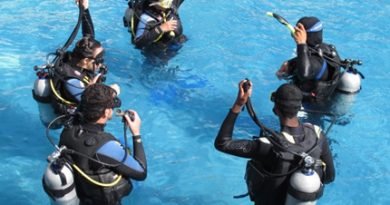How Deep Can You Dive With Scuba Gear
Table of Contents
How Deep Can You Dive With Scuba Gear?
Diving into the blue, the world beneath the waves is a realm of serene beauty, vibrant ecosystems, and uncharted territories that beckon the adventurous. Scuba diving offers a unique gateway to these underwater wonders, allowing us to explore coral reefs, shipwrecks, and marine life up close. But as we gear up and descend, one question often bubbles up to the surface: How deep can you dive with scuba gear? The answer isn’t just a number—it’s a dive into physics, physiology, and the very limits of human exploration under the sea.
Understanding the Depths: Scuba Diving Basics
The Role of Pressure in Scuba Diving
As divers descend, they encounter an increase in water pressure, a fundamental concept explained by Pascal’s Law. At sea level, atmospheric pressure is about 1 atmosphere (atm), equivalent to 101.325 kPa. For every 10 meters (approximately 33 feet) of seawater depth, the pressure increases by about 1 atm. This mounting pressure affects air consumption and buoyancy, necessitating careful adjustments to diving equipment and techniques.
Nitrogen Absorption and Decompression Limits
Diving deeper into the science of scuba, we encounter the principles of the partial pressures of gases, as described by Dalton’s Law. The deeper a diver goes, the greater the pressure and, consequently, the higher the partial pressure of nitrogen in the breathing gas. This leads to increased nitrogen absorption by the body’s tissues, a phenomenon governed by Henry’s Law. Exceeding safe limits of nitrogen absorption can lead to decompression sickness (DCS), limiting the safe depth and duration of dives without requiring decompression stops during ascent.
Advanced Techniques for Deeper Dives
Technical Diving and Mixed Gas Use
Venturing beyond recreational diving limits, technical diving emerges as a pathway to greater depths. Technical divers use specialized equipment and gas mixes, such as trimix (a blend of oxygen, nitrogen, and helium) to reduce nitrogen narcosis and oxygen toxicity risks. The inclusion of helium, with its lower narcotic effect, allows for clearer cognition at depths beyond the usual recreational limits of 40 meters (130 feet).
Decompression Strategies and Safety Protocols
Technical diving also demands rigorous decompression strategies to manage the increased risk of DCS. Divers plan their ascent to include decompression stops, allowing for the safe off-gassing of inert gases accumulated in tissues. This meticulous planning is supported by dive computers and tables, ensuring adherence to safe ascent profiles and minimizing DCS risk.
Equipment and Training: Keys to Exploring the Depths
Specialized Scuba Gear for Deep Diving
Deep diving requires gear that can withstand the extreme conditions encountered at depth. High-pressure steel tanks, durable regulators designed for cold water and high pressure, and advanced buoyancy control devices are among the essentials. Divers also rely on dive computers to monitor depth, time, and decompression obligations in real-time, crucial for managing the complexities of deep dives.
The Importance of Advanced Dive Training
Advanced dive training is imperative for those looking to push the boundaries of recreational diving. Courses in deep diving, technical diving, and emergency response prepare divers to handle the challenges of deep exploration. This education covers advanced buoyancy control, navigation, and emergency procedures, equipping divers with the knowledge and skills to safely explore deeper underwater realms.
In conclusion, the depth to which you can dive with scuba gear is not just a matter of equipment or desire; it’s a complex interplay of physics, physiology, and preparedness. The ocean’s depths hold wonders and risks, and understanding both is key to unlocking the mysteries beneath the waves safely. Whether you’re a recreational diver looking to explore a little deeper or an aspiring technical diver aiming for the extreme, the underwater world offers endless opportunities for discovery, adventure, and the push of human limits.
FAQs
What is the maximum depth for recreational scuba diving?
The generally accepted maximum depth for recreational scuba diving is 40 meters (130 feet). This limit is set to minimize the risks of nitrogen narcosis and decompression sickness, ensuring divers can safely enjoy their underwater adventures without specialized technical training.
Why is nitrogen narcosis a concern at depth?
Nitrogen narcosis, often called “the rapture of the deep,” is a concern at depth because it affects a diver’s cognitive function, similar to being intoxicated. As depth increases, the partial pressure of nitrogen in the breathing gas increases, leading to this narcotic effect. It can impair judgment and motor skills, making diving at depth riskier.
What is decompression sickness, and how can it be prevented?
Decompression sickness (DCS) occurs when dissolved gases, primarily nitrogen, form bubbles in the body due to rapid decreases in pressure during ascent. Preventing DCS involves adhering to safe ascent rates, limiting bottom time at depth to reduce gas absorption, and performing decompression stops if necessary, based on dive tables or dive computer recommendations.
Can you use regular air for deep diving?
While regular air (21% oxygen, 79% nitrogen) is commonly used for recreational diving within the no-decompression limits, deeper dives often require mixed gases to reduce the risks of oxygen toxicity and nitrogen narcosis. Trimix, which adds helium to the mix, is frequently used for deep technical dives to mitigate these risks.
How does technical diving differ from recreational diving?
Technical diving differs from recreational diving in its allowance for exceeding the conventional depth and time limits and often involves the use of mixed gases, multiple gas sources, and advanced equipment. It requires specialized training to manage the additional risks and complex procedures associated with deep and decompression diving.

